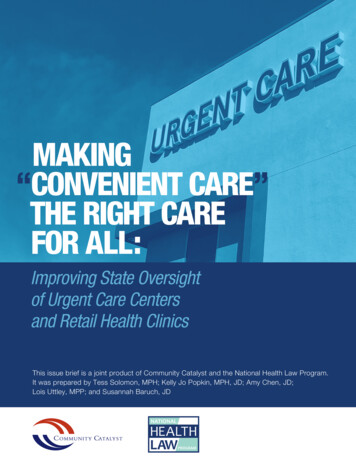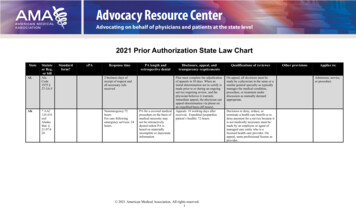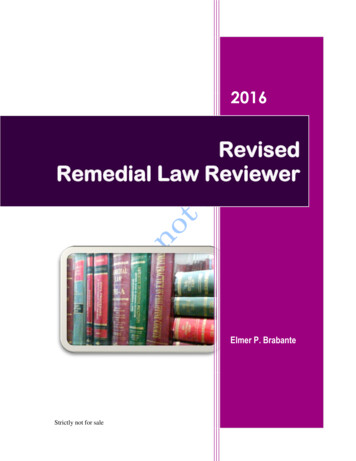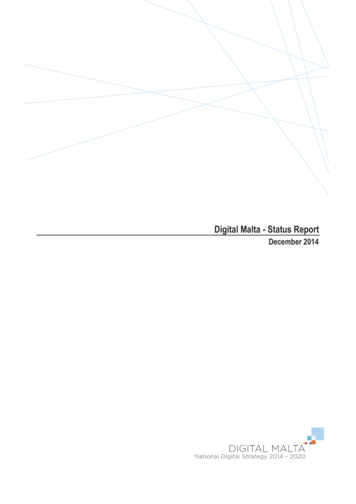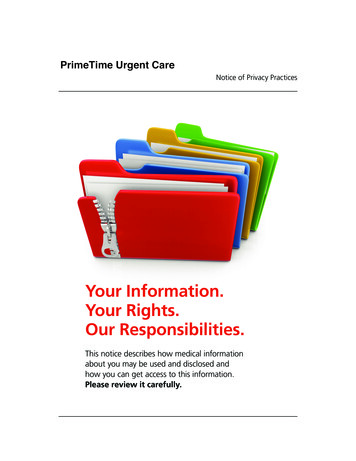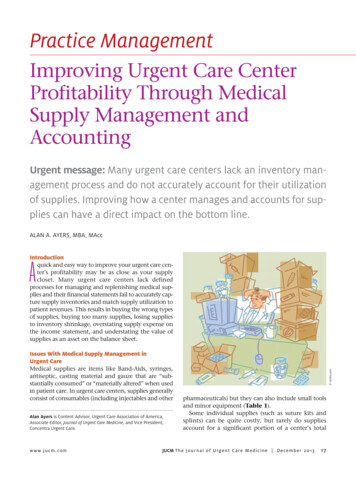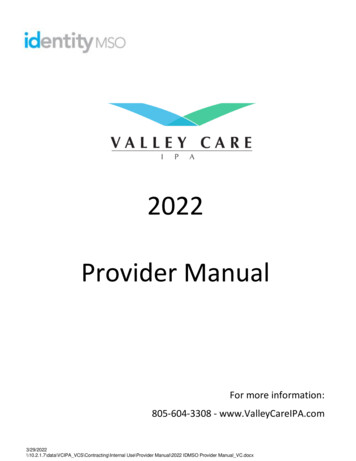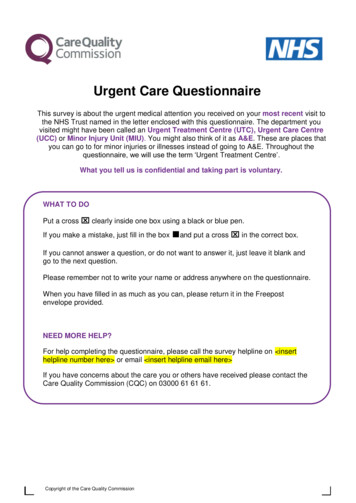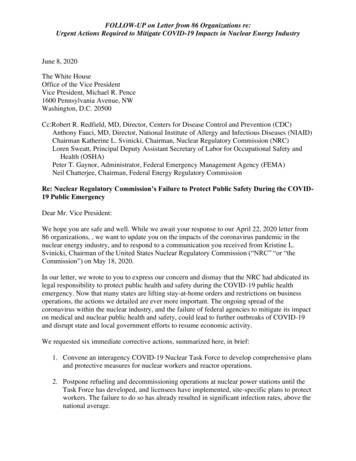
Transcription
FOLLOW-UP on Letter from 86 Organizations re:Urgent Actions Required to Mitigate COVID-19 Impacts in Nuclear Energy IndustryJune 8, 2020The White HouseOffice of the Vice PresidentVice President, Michael R. Pence1600 Pennsylvania Avenue, NWWashington, D.C. 20500Cc:Robert R. Redfield, MD, Director, Centers for Disease Control and Prevention (CDC)Anthony Fauci, MD, Director, National Institute of Allergy and Infectious Diseases (NIAID)Chairman Katherine L. Svinicki, Chairman, Nuclear Regulatory Commission (NRC)Loren Sweatt, Principal Deputy Assistant Secretary of Labor for Occupational Safety andHealth (OSHA)Peter T. Gaynor, Administrator, Federal Emergency Management Agency (FEMA)Neil Chatterjee, Chairman, Federal Energy Regulatory CommissionRe: Nuclear Regulatory Commission’s Failure to Protect Public Safety During the COVID19 Public EmergencyDear Mr. Vice President:We hope you are safe and well. While we await your response to our April 22, 2020 letter from86 organizations, , we want to update you on the impacts of the coronavirus pandemic in thenuclear energy industry, and to respond to a communication you received from Kristine L.Svinicki, Chairman of the United States Nuclear Regulatory Commission (“NRC” “or “theCommission”) on May 18, 2020.In our letter, we wrote to you to express our concern and dismay that the NRC had abdicated itslegal responsibility to protect public health and safety during the COVID-19 public healthemergency. Now that many states are lifting stay-at-home orders and restrictions on businessoperations, the actions we detailed are ever more important. The ongoing spread of thecoronavirus within the nuclear industry, and the failure of federal agencies to mitigate its impacton medical and nuclear public health and safety, could lead to further outbreaks of COVID-19and disrupt state and local government efforts to resume economic activity.We requested six immediate corrective actions, summarized here, in brief:1. Convene an interagency COVID-19 Nuclear Task Force to develop comprehensive plansand protective measures for nuclear workers and reactor operations.2. Postpone refueling and decommissioning operations at nuclear power stations until theTask Force has developed, and licensees have implemented, site-specific plans to protectworkers. The failure to do so has already resulted in significant infection rates, above thenational average.
3. Provide for immediate reevaluation by the Task Force of NRC exemptions to lift workhour limits for reactor power operations.4. Provide for immediate preparation of required Disaster Initiated Reviews (“DIR”) of theimpact of the pandemic on emergency response plans at all reactor sites and fuel cyclefacilities.5. Subject all current reviews of licensee-requested exemptions and deferrals to (a) acumulative risk analysis and (b) an integrated review by the COVID-19 Task Force.6. For any operations-related decisions, ensure that any potential safety impacts are fullymitigated. Work with regional transmission operators to determine which nuclearfacilities are necessary for electricity system reliability.Chairman Svinicki’s letter does not allay any of the concerns that we identified in our letter. It isa concise recitation of agency actions that NRC had publicly communicated in the weeks prior toour letter. It is the inadequacy and negligence of those actions that necessitated our letter to you.Chairman Svinicki’s communique contains no new information to indicate that NRC has takenany substantive action to address the problems we detailed. The NRC continues to place workersand communities in harm’s way during nuclear power operations. To date, nearly thirty nuclearpower stations have completed refueling outages during the pandemic, and dozens more arescheduled for later this year, beginning in August. Reports of infection rates in the industry havecontinued to rise, and there are several lessons learned that have not been implemented by theNRC.In her correspondence, the Chairman uses the term “public health” seventeen times. However, anagency has to be present to protect “public health.” The NRC has exercised “maximum teleworking” for its employees, but has not implemented or required similar safety standards fornuclear workers.The Chairman stated, “The NRC is monitoring the effects of the COVID-19 public healthemergency on NRC-licensed activities as well as actions taken in response to local conditionsand is poised to take appropriate regulatory steps as needed.” Yet, the NRC has still taken nomeaningful actions to protect the safety of workers or the public.The Commission is not requiring reporting of or tracking COVID-19 incidents, nor is itenforcing strict guidelines. The Nuclear Regulatory Commission has put the public and workersin harm’s way, and this inaction, in concert with licensees’ inconsistent, untransparent, andunaccountable approach, has accelerated the spread of the pandemic among the nuclearworkforce, in reactor communities, and potentially more widely.In her letter, Chairman Svinicki stated, “To date, the COVID-19 public health emergency has notresulted in safety issues or events at any NRC- licensed facility.” This is simply unsupported bypublicly available facts, and represents the Commission’s increasingly hands-off approach toregulation.FOLLOW-UP on Urgent Actions re: COVID-19 Impacts in Nuclear Energy IndustryPage 2
Chairman Svinicki assured you that the NRC was positioned to “protect public health and safety,including efforts to strike the right balance of inspection and oversight activities while limitingopportunities for the spread of the virus.” In fact, none of the statements in the Chairman’s letteraddresses the concerns detailed in our letter. They are almost entirely recitations of previousstatements NRC has made since the beginning of the pandemic.The Chairman’s communication is also misleading, and misrepresents the facts on the ground.The Commission has absented itself from the field of operations during the pandemic,disavowing any responsibility for mitigating infection risks to workers. Contrary to theChairman’s assertion, the NRC is not requiring systematic reporting or monitoring the effects ofthe COVID-19 public health emergency on NRC-licensed activities. NRC representatives havestated so in multiple public meetings and other forums since the advent of the public healthemergency. In short, the Commission is not tracking COVID incidents, nor is it enforcingguidelines for the protection of the nuclear workforce.NRC’s inaction has already resulted in health and safety impacts on hundreds of workers. Mediareports confirm that there have already been numerous COVID-19 outbreaks within the industry,including, but not limited to the Fermi, Limerick, Grand Gulf, Millstone, and Vogtle nuclearpower plants. This is a sampling of the impact of lax oversight of reactor operations andrefueling outages. Because the NRC and other federal agencies with responsibility to protectworkers’ health and safety have not instituted coronavirus reporting and tracking requirements(not to mention measures to maximize worker protections), there has been only anecdotalreporting of infection cases at reactor sites. It is, therefore, impossible to know the full extent ofcoronavirus spread within the industry, what measures are working and not working, and whatimpact the pandemic is having and may have on nuclear safety and security.Nevertheless, it is clear that infection rates at reactor sites are far exceeding the national average.The following number of exposures and incidents have been reported in the media from Marchthrough May: Fermi (Michigan): As reported on May 12, at the Fermi, unit 2 reactor site in Michigan,over 200 out of 2,000 full-time and refueling outage workers have tested positive, agreater than 10% infection rate.1Grand Gulf (Mississippi): News media reported 89 positive cases at the Grand Gulfnuclear station, as of April 29.2Limerick (Pennsylvania): On April 8, media outlets reported that three workers at theLimerick Nuclear Power Plant had tested positive, and over 40 were in quarantine,including two dozen exhibiting COVID-19 symptoms.3 Multiple workers complained oflack of social distancing, sanitation, and other protective measures. County officialsrejected Exelon’s coronavirus plan, and requested that the company postpone the 08.htmlFOLLOW-UP on Urgent Actions re: COVID-19 Impacts in Nuclear Energy IndustryPage 3
person refueling operation until it had put adequate protections in place. The companyrefused, and proceeded anyway.Millstone (Connecticut): Security guards at the Millstone 2 and 3 reactors havecomplained about inadequate sanitation, protective measures, and PPE since April.4 AFreedom of Information Request to state authorities revealed that positive cases increasedmore than ten-fold in 11 days, rising from one to eleven cases by April 24, whenMillstone began a refueling outage.5 Infected workers included three control roomoperators.Plant Vogtle (Georgia): Between April 11 and May 19, media reports on coronaviruscases at the Plant Vogtle site in Georgia increased from 136 to 230 workers.7 More recentreporting has not been available, despite the ongoing presence of over 7,000 workers onthe construction site of units 3 and 4.None of these workplace conditions would be tolerated by NRC staff working in Bethesda,Maryland, King of Prussia, Pennsylvania, or the agency’s other regional offices. The NRC’sspokesperson, Scott Brunell, declared in a public meeting that 96% of their work force was at“maximum tele-working.” The NRC, out of an abundance of caution, sequestered theiremployees, and implemented “virtual oversight.”However, the NRC was not present to witness crowded and non-compliant work sites. Workersare frightened, and in many instances forced to work overtime in unsafe conditions due topressure from licensees. Many licensees have refused to provide hazard pay, forced employees touse vacation time, and have not practiced sufficient social distancing or provided adequateprotections.Refueling workers are migratory and must live in communal accommodations during the outage,from hotels and motels, to campers and campsites, to home rentals and AirBnB’s. Since theirwork is seasonal, they rely on the NRC to protect their heath and safety. Moreover, theseworkers travel from reactor site to reactor site during the spring and fall “refueling outageseasons.” They have their permanent residences in other states and return to their homes afteroutages.We have participated in numerous COVID-19 exemption meetings throughout the winter andspring. The licensees and the Nuclear Regulatory Commission have been focused on fasttracking approval of exemption and deferral requests, and have placed economics and speedabove protection of health and safety.The Commission’s meetings are non-responsive and scripted events. The NRC and licenseesrarely follow up on commitments or data requests. The NRC would not know what actions totake “in response to local conditions” nor is it “poised to take appropriate regulatory steps asneeded,” because the entire agency is vogtle-georgia-powersays/article 570595101.html5FOLLOW-UP on Urgent Actions re: COVID-19 Impacts in Nuclear Energy IndustryPage 4
Complicating an already difficult situation is the reactor owners’ reluctance to share data withlocal and state officials. The Limerick Nuclear Station is a prime example of the disconnectedresponses from the licensee to municipal, county and state government officials. Similarly, theselocal and state governments are the same entities charged with implementing emergencyplanning.Chairman Svinickiis correct in stating the NRC has “implemented a flexible strategy.” TheCommission’s “flexible strategy” for NRC resident inspector site-coverage is “such that each siteshould be visited by a resident inspector at least once every three business days to perform plantinspections.” It is hard to “monitor” a site when you are not at the site.Finally, regarding emergency planning, we called for NRC and FEMA to conduct reviews ofeach nuclear facilities emergency response plans—a measure that is required by both agencies’operational guidelines whenever a natural disaster or pandemic might affect a nuclear facility. Asdetailed in our letter, this “disaster-initiated review” (DIR) requirement is specified in alongstanding memorandum of understanding between the agencies, to ensure that emergencyresponse plans either remain adequate, or that compensatory measures can be implemented toprotect the public health and safety. NRC and FEMA have conducted them regularly over theyears, whenever, for instance, a hurricane is projected to make landfall near a nuclear facility.These reviews, by necessity, involve a comprehensive evaluation of all critical aspects of thefacility’s offsite emergency response plan. Take, for instance, the review FEMA conducted inSeptember 2019 of the ERP for the St. Lucie Nuclear Power Plant in Florida when HurricaneDorian was projected to make landfall in the vicinity.8 FEMA’s preliminary review concludedthat the ERP was not impacted, based on consulting with state and local agencies and gatheringinformation on the following elements of the ERP:1. Emergency Response Facilities2. Communications3. Emergency Response Organizations4. Public Alert and Notification Systems5. Access and Functional Needs and Transportation Routes6. Evacuation Routes7. Accident Assessment8. Population Shifts9. Support Services10. Supporting DocumentationAt the time we delivered our April 22 letter to you, five weeks after the public health emergencyhad been declared, FEMA had completed no DIRs for any nuclear facilities in the U.S. Over thelast two weeks, NRC has posted eight letters from five FEMA regional offices indicating thatFEMA had conducted reviews of the pandemic’s impact on offsite emergency response8Federal Emergency Management Agency. “Preliminary Capabilities Assessment – St. Lucie Nuclear Power Plant.”September 6, 2019. p?AccessionNumber ML19253C792FOLLOW-UP on Urgent Actions re: COVID-19 Impacts in Nuclear Energy IndustryPage 5
organizations for 17 reactor sites.9 However, it appears that the reviews conducted by FEMA areincomplete. All of the letters except for one indicate that the agency only assessed one elementof the ERPs: “examination of the local offsite response organizations.” (The other letter, fromFEMA Region VII, dated May 27, 2020, does not specify the scope of review.) In addition, theFEMA Region III letter notes that it only reviewed the status of the offsite responseorganizations for the Salem-Hope Creek nuclear complex in Delaware. FEMA Region II, wherethe complex is located does not appear to have filed a letter with NRC, to date.FEMA’s apparent failure to review the adequacy of emergency response facilities, supportservices, and access and functional needs (e.g., public transportation) for over a dozen nuclearfacilities during a pandemic would be negligent, given the need for social distancing, shortage ofPPE, reduced capacity of public transportation systems, and the overstretched capacity ofhospitals and first responders.In addition, it is not clear whether even the limited scope of these reviews were thoroughlyconducted. Nearly all of the letters appear to be pro forma communications. Although they weresubmitted by five different FEMA regional offices five of the eight letters are nearly identical intheir wording. Aside from the names of the nuclear facilities and some corresponding phrases,the letters are almost entirely verbatim with one another, word-for-word. The letters also containfar less detail about the activities involved in FEMA’s review than other recent DIR letters, suchas the 2019 St. Lucie letter above.Taken on the whole, the Commission has been virtually absent amid the greatest public healthdisaster in the agency’s existence. It has thus far refused to coordinate with other governmentalbodies and declared that its authority is limited to radiological safety impacts, by which itappears to mean imminent nuclear disasters. The NRC simply granted dozens of exemptionsthrough rushed, cursory reviews. The Commission’s “expectations” are not aligned with thereality of a real-time pandemic.This cannot be allowed to continue. Nuclear workers are the first and last line of defense for thepublic health and safety, risking their lives to protect the country every day. They and theircommunities need and deserve protection during the pandemic. A coordinated, comprehensive9FEMA Region I. Dated June 2, 2020. Re: Millstone and Seabrook nuclear power main.jsp?AccessionNumber ML20157A036FEMA Region III. Dated May 19, 2020. Re: Beaver Valley, Calvert Cliffs, Limerick, North Anna, Peach Bottom, SalemHope Creek, Surry, Susquehanna, and Three Mile Island nuclear power main.jsp?AccessionNumber ML20141L795FEMA Region VII. Dated May 27, 2020. Re: Duane Arnold and Quad Cities nuclear power main.jsp?AccessionNumber ML20154K618FEMA Region VII. Dated May 28, 2020. Re: Calloway Energy main.jsp?AccessionNumber ML20154K696FEMA Region IX. Dated May 20, 2020. Re: Diablo Canyon and Palo Verde nuclear power main.jsp?AccessionNumber ML20150A151FEMA Region IX. Dated May 22, 2020. Re: Diablo Canyon and Palo Verde nuclear power main.jsp?AccessionNumber ML20150A110FEMA Region X. Dated June 1, 2020. Re: Columbia Generating /main.jsp?AccessionNumber ML20154K703FOLLOW-UP on Urgent Actions re: COVID-19 Impacts in Nuclear Energy IndustryPage 6
federal response is needed to mitigate the impact of COVID-19 within the nuclear industry,and—with refueling outages at over two dozen more facilities currently scheduled for the latersummer and fall—you must act now to prevent further negligence by NRC and the industry itregulates.We anxiously await your response to our April 22, 2020 correspondence, and call on you toadopt and implement our six recommendations prior to the resumption of the next round ofrefueling outages.Sincerely,Timothy JudsonExecutive DirectorNuclear Information and Resource Service6930 Carroll Ave., Suite 340Takoma Park, MD 20912TimJ@nirs.org(301) 270-6477Eric EpsteinPresidentThree Mile Island AlertMiddletown, PAlechambon@comcast.netNikos PastosAlaska’s Big Village NetworkAnchorage, AK 99504nikospastos@hotmail.comPaul GunterDirector, Reactor Oversight ProjectBeyond NuclearTakoma Park, MDpaul@beyondnuclear.orgDeb KatzExecutive DirectorCitizens Awareness NetworkShelburne Falls, MAdeb@nukebusters.orgMary GutierrezExecutive DirectorEarth Action, Inc.Pensacola, FLearthethicsaction@gmail.comMary Beth BranganCo-DirectorEcological Options Network, EONBolinas, CAmbbrangan@gmail.comManna Jo GreeneEnvironmental DirectorHudson River Sloop Clearwater, Inc.Beacon, NYea1@clearwater.orgSheila Parks, EdDFounderOn Behalf of Planet EarthWatertown, MAsheilaruthparks@comcast.netBart Ziegler, PhDPresident and Co-FounderSamuel Lawrence FoundationDel Mar, CAbart@samuellawrencefoundation.orgFOLLOW-UP on Urgent Actions re: COVID-19 Impacts in Nuclear Energy IndustryPage 7
emergency on NRC-licensed activities as well as actions taken in response to local conditions and is poised to take appropriate regulatory steps as needed." Yet, the NRC has still taken no meaningful actions to protect the safety of workers or the public. The Commission is not requiring reporting of or tracking COVID-19 incidents, nor is it
